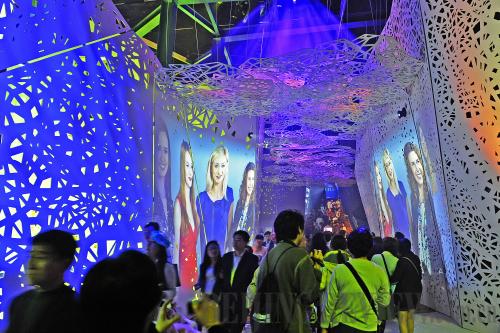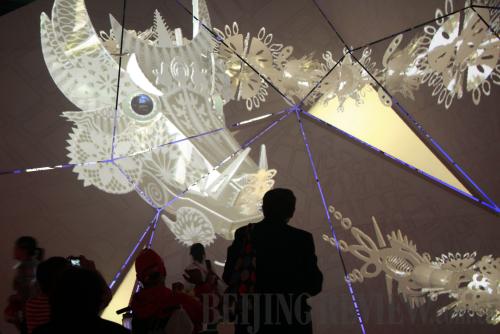|
 |
|
EXPERIENCING POLAND: Visitors walk down a hall decorated with digital screens in the Poland Pavilion at the World Expo in Shanghai on May 1 (GUO CHANGYAO) |
Unlike many pavilions shining with the very latest technological wonders, the Poland Pavilion stands out for its cultural charm.
From dawn to dusk, long queues of visitors wait patiently to catch a glimpse of the mystery of the distant central European country, with neither chilly drizzle nor blazing sun affecting their enthusiasm. And despite the continental distance between Poland and China, with the first steps into the pavilion Expo visitors will see just how much the two countries have in common.
The 3,000-square-meter pavilion, mainly made of wood, gives the impression of a huge folded box of paper cutouts, a folk tradition of Poland and China. During the day, sunlight can enter the main exhibition hall through cracks in the walls. In the evening, the pavilion shines from within, changing colors to light up the dark sky and making it seem as if the cutout figures are dancing on the walls.
The cutouts are used as Christmas and Easter decorations in rural areas. Polish craftsmen can cut out an intricate pattern continuously, without clipping any piece of paper midway, Anna Rudawska, Press Officer at the Bureau of the Commissioner General of the Polish Section of Expo 2010, told Beijing Review.
Most construction materials for the pavilion are recyclable, and after the Expo concludes in late October, part of the wooden structure will be reconstructed in a Polish city. "The pavilion design evokes ancient artistry, abstract design and futuristic thinking," said Slawomir Majman, Commissioner General of the Polish Section of Expo 2010.
"We just want to show the world that one can lead a good and comfortable life in Polish cities, combining a respect for the past and tradition with the challenges of the present and the future," he said.
Past and present
Wandering through the pavilion, imprints of Polish history are everywhere. The solid inner walls are installed with digital screens telling vivid stories about how the country went through two world wars, the industrial revolution, as well as the latest financial storm.
Despite the lasting traumas, the Poles have never given up the joys of life and the hope for a better tomorrow, said Majman. "That is how we understand the motto of the pavilion—Poland is Smiling."
Indeed, barely a corner of the pavilion is left out of the joyous mood. A curved path leads visitors through the four seasons in a rural Polish landscape where the spring and summer blossom with vitality and intense colors, while autumn and winter offer snowy serenity. With the splendid mountains and calm deep lakes in sight, visitors feel as if they have left the hustle and bustle of the city behind.
The stirring sounds of music from beloved Polish pianist and composer Frederic Chopin reverberate through the air, touching the hearts and minds of listeners. When dusk falls, the pavilion becomes a dazzling dance floor where passion and energy never recedes. Boys and girls, and men and women indulge themselves in the party, shaking and bouncing to rhythms of classic Polish folk music.
Culturally connected
It's more than just the paper cutouts that make the Chinese feel more at home in the Polish Pavilion. An animated dragon, projected on the interior wall, swings and draws constant laughter and cheers from the crowds.
Rudawska said Poles also tell legendary fairytales about dragons, though it is less of a symbol than in China where it is considered synonymous with the emperor and power.
It is said that a horrible and ever-hungry dragon used to live in the Wawel Hill of Poland. The beast would order lambs and young girls to eat in exchange for peace. With the town running out of girls, the king feared he would soon lose his own daughter, so he promised her hand in marriage to whoever killed the dragon. Many knights tried but failed, until one day a most inconspicuous person came to the rescue.
His name was Skuba Dratewka, a shoemaker's apprentice. He stuffed a lamb's skin with sulfur and tar, and left it near the dragon's cave. The hungry beast soon devoured the poisonous treat and immediately became very thirsty. It started drinking from the river, but the terrible thirst did not go away, so it drank even more until it burst in a powerful explosion. Dratewka the dragon-killer married the princess and they lived, as the story goes, "happily ever after."
But fairytales and mythological creatures are not the only resemblances between China and Poland—the European country also experienced a prolonged and painful urbanization process from the 1940s to the 1970s, said Majman.
Many Polish farmers poured into big cities searching for a wealthier life, only to find that the cities were not a wonderland where bread and butter were easily within their reach. The pavilion displayed short movies about five Poles struggling to adapt to city lives and eventually becoming successful singers, models and entrepreneurs.
"We want to send a message to the Chinese people that the transition from countryside to cities may be difficult, but a happy ending is almost certain," Majman said.
"As part of our preparations for the Expo, we took a poll of Chinese in Beijing and Shanghai, and were surprised to find that a majority of them knew very little about Poland. Some even have no clue where the country is," he said. "So we hope that these Chinese-style elements can help the visitors cross the barrier of unfamiliarity and have a better understanding of Poland."
Unforgettable memory
 |
|
DRAGON FROM THE WEST: An animated Polish dragon, projected on the wall, entertains visitors at the Poland Pavilion on May 1 (WANG YING) |
The glamour permeating the Poland Pavilion has been so appealing that it's no surprise very few visitors have come away disappointed.
The pavilion received more than 27,000 visitors in the first three days of the Expo, 90 percent of whom were Chinese, said Rudawska. "The number is expected to further increase as more colorful cultural activities are scheduled after May 22, our National Pavilion Day," she said.
After visiting the Poland Pavilion on May 3, China's Vice Foreign Minister Fu Ying said she was impressed by the national pride and warm smiles of the Poles.
"The Expo has bridged the distance between the two countries, and will help deepen friendship between the Chinese and the Poles," she said.
"There are so many highlights to see that I lost track of time. The paper cutout pattern in particular is breath-taking," said Liu Yumiao, a 24-year old graduate student from northeast China's Liaoning Province. After waiting for 40 minutes at the entrance in the morning, she became the first visitor to the pavilion on May 6.
"But it is completely worth queuing up for. The unique combination of Polish traditions and moderness make you forget about the outside world," she said. "When I started listening to Chopin 10 years ago, it was the beauty that struck me. That is why I have always wished to travel to Poland and know more about the country."
Majman said Poland is taking the spotlight as an attractive tourist and investment destination.
With a safe, extensive and sustainable market, Poland can act as an entryway to Europe for Chinese companies, he said.
While many neighboring economies are still reeling, Poland has navigated safely through the financial storm and was the only European Union member that recorded economic growth in 2009.
Basic Information
Capital: Warsaw
Population: 38.5 million
Area: 312.7 square km
Climate: temperate, continental
GDP growth rate in 2009: 1.4 percent
| 